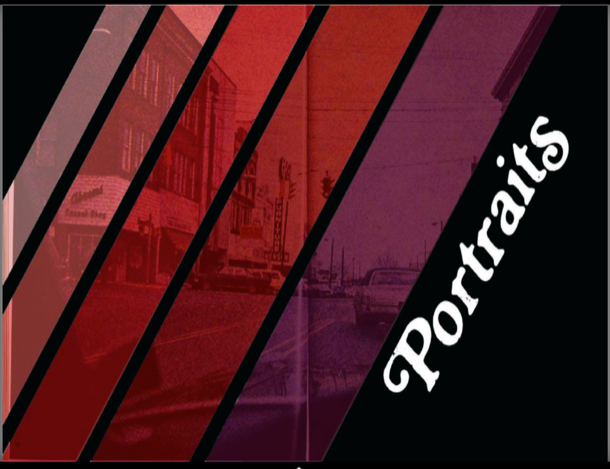Clarke Central High School CTAE Department co-chair and Gladius yearbook adviser Nestor Domingo helps a yearbook staffer in his classroom on Oct. 2, 2019. The yearbook staff has had to make changes to how they function as a group in the yearbook-making process. “I think that (the year) went really well (for the yearbook staff),” Domingo said. “Jobs were much more specialized (then usual), but people were (still) able to work independently. I knew from the beginning that the challenges of this year were not going to fit well with a large group, so everything worked out really well.” Photo by Owen Donnelly
Throughout the COVID-19 pandemic, the Clarke Central High School yearbook staff has been working to ensure that CCHS students and staff have a physical yearbook in what has been a primarily virtual year.
According to Gladius Editor-in-Chief Amelia James, a junior, the program has changed its traditional processes in the past year to facilitate the new safety requirements prompted by the COVID-19 pandemic.
“There (were) no jobs that were specific. We all just did everything. (That led to) a lot of conflict between staff (members) and not a lot of communication.”
— Amelia James,
CCHS junior and Gladius Editor-in-Chief
“When we had a larger staff, we didn’t really have a good way of assigning work. We tried to get everyone to interview people, get stories, take pictures and design spreads. There (were) no jobs that were specific. We all just did everything,” James said. “(That led to) a lot of conflict between staff (members) and not a lot of communication. This year it’s been me, (Clarke Central High School CTAE Department co-chair and Gladius yearbook adviser Nestor) Domingo, (junior and Gladius Proof Editor Tripp) Sandifer and (junior and Gladius Sales and Marketing Coordinator Sophia) Long and I can easily get in contact with any of them at any time. It’s a more close-knit group. We get along a lot better and we split up (all) the work.”
According to Long, it has been difficult for the staff to continue their work during this year due to circumstances that have limited their abilities, such as safety precautions pertaining to COVID-19.
“(This year) is really weird because you can’t just go into a classroom and take a candid picture like how we would do (in a regular) year,” Long said. “So we don’t really have a lot of pictures, or the pictures that we do have are (of) people with masks. It’s hard because you can’t really see a lot of people’s faces, and it’s just hard getting interviews because we couldn’t go in person, we had to do everything online.”
Even with some availability for staff meetings, the difficulty of in-person photography proved to be a substantial roadblock.
“(This year) is really weird because you can not just go into a classroom and take a candid picture like how we would do (in a regular) year,” Long said. “So we do not really have a lot of pictures, or (the) pictures that we do have are (of) people with masks. It’s hard because you can’t really see a lot of people’s faces, and it’s just hard getting interviews because we couldn’t go in person, we had to do everything online.”

The 2021 Gladius Yearbook portrait divider, which was designed by members of the Gladius staff, is displayed. According to Clarke Central High School Gladius yearbook adviser Nestor Domingo, the staff worked to maximize the size of the portraits section. “Some things are missing (from the yearbook) that have been there before, but we were able to focus on the (portraits this year),” Domingo said. “I think that will be where we go forward from now on, just focusing on those images so there’s more space (spent) on that.” Yearbook preview courtesy of Nestor Domingo
The issue with getting viable photos was compounded further because of delays from the yearbook company Lifetouch, which photographs and prepares portraits for publication.
“Hopefully we will not have to rely on Lifetouch (again) because they fell behind with giving us (our photos). There was a point where we had very little work to do because we did not have any pictures, portraits or stuff like that. It was also really complicated, trying to get people to come to the school and take pictures. We got a lot of submissions of people who took their own pictures, (but) I had to change some of those (due to the quality),” Sandifer said.
According to Sandifer, the availability of photos was heavily dependent on cooperation between the yearbook staff and potential subjects for said photos.
“We were definitely having to get in contact with all these people, (and) not everyone was cooperative. We had to email multiple teachers and some of them we just gave up on,” Sandifer said. “(There were) definitely some people who kind of blew us off. That was the hardest part (of getting photos).”
James will return in the fall as Editor-in-Chief again, and Domingo will bring on additional members to return to a more full-sized production team as a class.
“I can see the (final) product more clearly now. I can see the possibilities (of the yearbook, but) I find that the challenge is still there, (with) so many things having been truncated,” Domingo said. “I’m getting a sense of what can be done with this group, and being able to then expand it (next year).”
Story by Atonio Starks, Owen Donnelly, Lillian Sams and Isabella Johnson
Package by Ireland McCage
